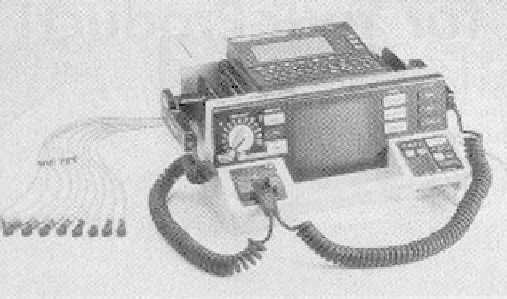Biomedical Engineering Reference
In-Depth Information
of 10-30 Hz. This is far in excess of the 10-30 breaths per
minute encountered in spontaneous or mechanical ven-
tilation. These high-frequency breaths produce lower
peak airway pressures, possibly reducing lung injury.
entail the use of a transthoracic pacemaker. Pacing also
can be done by inserting a pacing catheter in the right
heart, which is then connected to a small, external
pacemaker.
The aforementioned interventions effectively treat
conduction or electrical defects that can arise spontane-
ously or in response to infection or myocardial infarction.
The heart muscle is, for the most part, largely intact.
When the heart muscle fails, additional measures must
be taken, to sustain the patient's life. At the ICU bed-
side, this is accomplished by the use of the IABP (Jaron
and Moore, 1988). A special catheter is inserted into the
aortic arch containing a balloon that can be rapidly
inflated and deflated by a low-viscosity gas, usually
helium. The timing of the balloon inflation is synchro-
nized to either the patient's ECG or blood pressure
waveform. Its primary purpose is to improve perfusion of
the heart muscle by inflating the balloon as the aortic
valve opens, providing additional backpressure to the
carotid arteries and rapidly deflating it so that the rest of
the body can be perfused. This procedure sustains the
patient as the myocardium can recover sufficiently to
pump on its own. In the event that a replacement heart is
required, the procedure will extend a patient's life until
a donor heart is available.
Alternatively, there are a number of LVADs that en-
hance the pumping action of the left ventricle until
a donor organ is found (Rosenberg, 1995). They are
surgically implanted in the patient's chest or abdomen
and are managed by the ICU staff. Less widely used,
though available also, is the ECMO, or heart lung ma-
chine (Dorson and Loria, 1988). This device, used during
coronary-artery bypass graft, can provide both re-
spiratory and circulatory function, allowing the heart and
lungs to be mechanically inactive for a time. Efforts such
as this are extreme and require significant technical
support during use.
Cardiac care
Among some of the more frequently utilized devices in
cardiac care are the defibrillator (see
Figure 4.2-4
),
pacemaker, intra-aortic balloon pump (IABP) (Jaron and
Moore, 1988), left ventricular assist device (LVAD)
(Rosenberg, 1995), and extracorporeal membrane oxy-
genator (ECMO). For decades, life-threatening cardiac
rhythm disturbances (e.g., ventricular fibrillation, ven-
tricular tachycardia, and atrial fibrillation) have been
successfully addressed utilizing defibrillators (Tacker,
1988). These devices have been standard in the ICU
since their inception decades ago. Little has changed in
their basic operation. They all deliver energy over a wide
range of output energy and have had the ability to be
synchronized (i.e., to perform ECG-synchronized
cardioversion). Recently, however, the use of biphasic
waveforms has been revisited. The assumption (not yet
accepted in wide-ranging studies) is that more successful
cardioversion can be achieved at lower energies, thus
avoiding potential damage to the myocardium. Addi-
tionally, the refinement of arrhythmia detection has
allowed these devices to be automated, detecting dan-
gerous cardiac events and firing the defibrillator without
the need for operator intervention. Additionally, many of
these units can be configured to perform transthoracic
pacing.
Because of myocardial infarction, or for other
reasons, patients sometimes develop temporary or
permanent heart block, preventing the heart's conduc-
tion system from beating at an appropriately consistent
rate. A pacemaker is typically utilized to correct this
condition. Depending on the acuity of a patient's con-
dition,
the
first-order
intervention
probably
would
Infusion devices
Most ICU patients arrive with some form of vascular
access and usually receive additional IV lines during their
stay. Much of the therapeutic intervention and monitor-
ing occurs via vascular access. Fluid management and
drug delivery can be accomplished using gravity as the
source of positive pressure to push liquids into the
patient. Infusion rates are monitored visually, and ad-
justments can be made to achieve the required goals. This
approach is not viable when six to eight infusions are
running simultaneously, with rates varying from 0.1 cc/
hour, for certain pain medication, to hundreds of cc/hour,
for rapid fluid replacement. This is handled now with
a variety of programmable infusion pumps (
Figure 4.2-5
)
and controllers (Voss and Butterfield, 1995).
Figure 4.2-4 Defibrillator.








